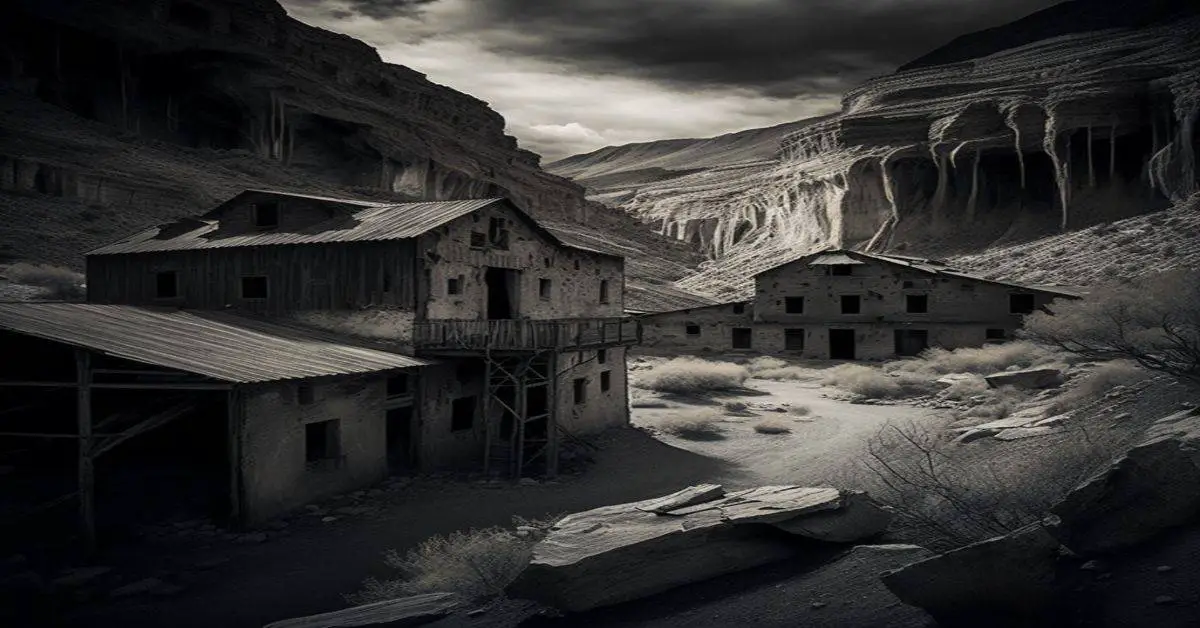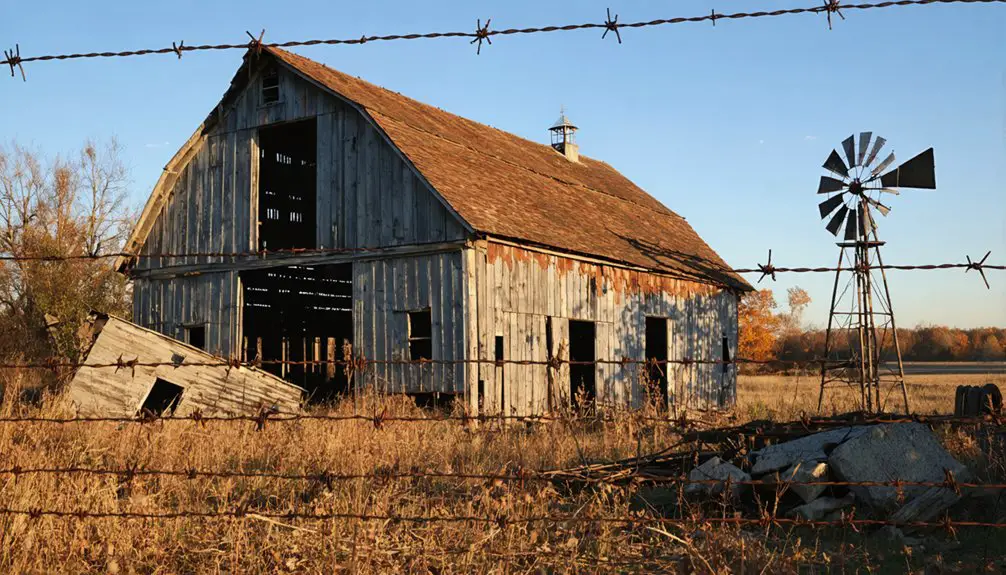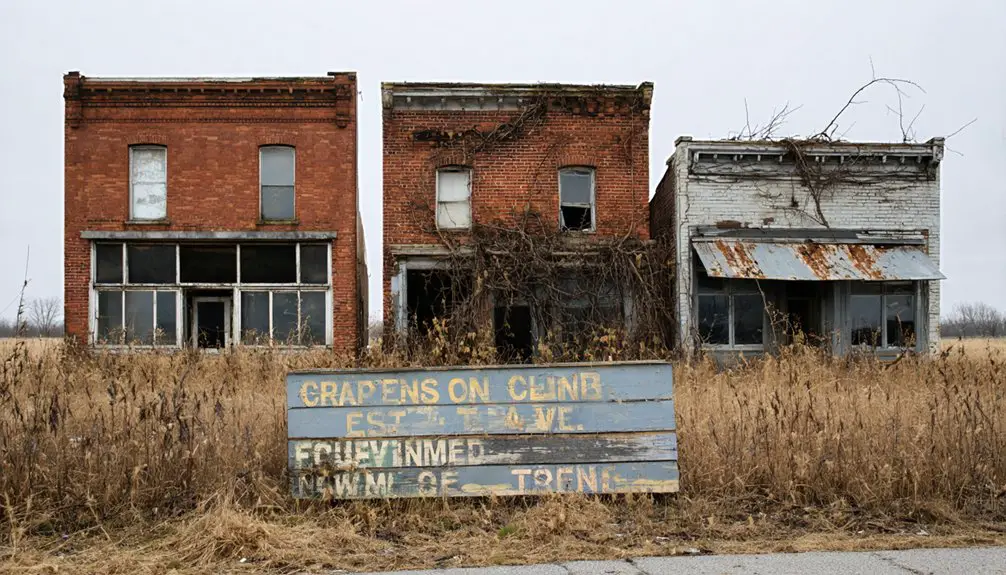You’ll find White Water Shaker Village, established in 1822, about 22 miles northwest of Cincinnati along the Dry Fork of the White Water River. This once-thriving religious commune now stands as a preserved ghost town featuring 23 original Shaker structures, including the 1820 Meeting House. The village’s rich history of communal living, farming, and manufacturing is carefully maintained through over $1 million in annual preservation efforts. Each building tells a deeper story of Ohio’s Shaker movement.
Key Takeaways
- White Water Shaker Village in Ohio experienced significant population decline, transforming from a thriving religious community into an abandoned settlement.
- The community’s decline began with decreasing Shaker membership, leading to eventual abandonment of many original buildings and structures.
- 23 preserved Shaker structures remain today, maintained by preservation groups and Great Parks of Hamilton County.
- The village’s transformation into a ghost town reflects the broader decline of Shaker communities across America during the 20th century.
- The site now serves as a historical landmark and educational center, with annual investments exceeding $1 million for preservation.
The Birth of White Water Settlement
While several Shaker communities dotted the American landscape in the early 1800s, White Water Settlement emerged in 1822 when members of the Union Society of Shakers from Lebanon, Ohio, established their presence near Mt. Tabor Methodist Church in Morgan Township.
You’ll find that three prominent Butler County families joined by 1823, strengthening the settlement’s foundation through their property donations. The community’s official establishment came in 1824 when Union Village Trustees purchased land, creating a hub for Shaker beliefs and communal rituals. The settlers chose this location for its rich fertile soil and abundant natural resources.
Former Darby Plain preacher Nathan Burlingame’s arrival consolidated spiritual leadership. Despite facing initial hardships on poor, forested land, these determined settlers persevered. The settlement grew significantly when West Union dissolved in 1827, bringing new members to the community.
Location and Natural Resources
You’ll find Shaker Village positioned strategically in Cuyahoga County, roughly 9 miles southeast of Cleveland at an elevation of 1,050 feet above sea level.
The village’s early settlers capitalized on the area’s natural resources, including fertile soil for farming and the extensive network of streams and wetlands that would become known as Shaker Lakes. The area contains the oldest house in Cuyahoga County.
While the region wasn’t rich in extractable minerals, its mixed hardwood forests and gently rolling terrain provided ideal conditions for establishing a self-sustaining community. The area’s watershed includes several notable bodies of water like Horseshoe Lake and Marshall.
Strategic River Settlement
Located 22 miles northwest of Cincinnati, Shaker Village‘s strategic position along the Dry Fork of the White Water River proved essential to its development and sustainability.
You’ll find this waterway served multiple critical functions, supporting both river navigation and agricultural sustainability through its fertile floodplain soils.
The river’s presence shaped the village’s success by providing water for domestic needs, farming operations, and possible industrial activities like seed production.
You can trace how the Shakers maximized their location’s advantages, utilizing the rich soil near the waterway for crop cultivation while accessing abundant timber from surrounding woodlands.
The settlement’s proximity to the river created an ideal microclimate for diverse crop growth and enabled effective drainage, while supporting livestock needs and potentially powering small mills.
Early settlers were drawn to the area’s rich soil and timber, which provided the essential natural resources needed to establish and grow the community.
The village’s 800 acres of land allowed for extensive agricultural development and community expansion over its nearly century-long operation.
Natural Resource Management
As the Shaker Village expanded through northeastern Ohio at coordinates 41°28′35″N 81°33′6″W, its natural resource management reflected a strategic balance between utilization and preservation.
The Oris and Mantis van Sweringen brothers initiated the area’s development in 1905, transforming the landscape while maintaining its natural features.
You’ll find evidence of sustainable practices in how they dammed streams to create Horseshoe Lake and Lower Shaker Lake, powering their gristmills while maintaining water resources.
The community’s biodiversity conservation efforts are visible today through the Nature Center at Shaker Lakes, where you’re able to explore protected wetlands and forests.
They’ve preserved the original watershed features within the 6.3-square-mile area, situated 6 miles from Lake Erie.
You can witness their environmental planning legacy in the Garden City design, which integrates natural topography with residential zones while protecting native wildlife habitats and water quality.
Architectural Heritage and Design
You’ll find the meetinghouse at the heart of this Shaker village, showcasing its symmetrical gambrel roof and balanced façade that typified their commitment to order and spiritual expression.
The interior’s plain, functional design supported their distinctive worship practices, including ecstatic dancing and communal singing, with ample natural light streaming through its numerous windows. The building exemplifies the renowned craftsmanship that made Shaker furniture and architecture highly influential in American design.
The surrounding residential buildings were purposefully arranged in family units, reflecting the Shakers’ dedication to communal living while maintaining their characteristic emphasis on simplicity and practical craftsmanship. Like the Mount St. Vincent Academy, the main structures were built in the mid-1800s to serve their unique communal needs.
Meeting House Design Features
While many colonial-era buildings featured ornate designs, Shaker meetinghouses exemplified architectural simplicity through their distinctive features and practical construction methods.
You’ll find the meetinghouse aesthetics reflected their commitment to austerity and functionality, with clapboard exteriors and sturdy granite foundations. Gender segregation shaped the buildings’ layout, featuring four front doors – two for men and two for women – ensuring orderly, separate access to worship spaces. Modern researchers at the University of Cincinnati are working to create virtual 3D reconstructions of these historic structures.
- Massive granite posts, weighing up to 2,000 pounds, supported open floor plans for vigorous dancing
- Plain wood pegs and built-in hooks replaced decorative storage solutions
- Gambrel or gable roofs topped symmetrical façades with evenly-spaced entrances
- Innovative roof truss systems eliminated the need for interior support pillars
- Gender-specific staircases and ells maintained separation during gatherings
Communal Living Spaces
The Shaker commitment to communal living manifested in their ingenious architectural designs, where buildings seamlessly integrated gender separation with functional efficiency.
You’ll find separate staircases and distinct living spaces for men and women within the same structures, allowing for communal harmony while maintaining their strict gender roles.
The buildings showcased remarkable resource efficiency through built-in storage solutions and multi-purpose spaces.
Servants’ quarters were strategically placed in upper stories or carriage houses, while sliding doors in laundries enabled controlled interactions between genders.
The interiors featured unadorned, rectilinear designs with plain wooden furnishings and pegged construction, reflecting their austere aesthetic.
Every architectural element served both practical and social purposes, from the parallel alignment of buildings along central roads to the integration of living, working, and worship spaces.
Daily Life in the Shaker Community
Living in a Shaker community meant embracing a highly structured lifestyle governed by religious principles and communal organization.
You’d start each day with spiritual practices and prayer, followed by shared work duties and communal meals. The rhythm of daily life centered around collective activities that fostered both productivity and spiritual growth.
- You’d live in gender-segregated quarters but gather regularly for worship, meals, and social activities.
- Your work would be viewed as a form of worship, whether farming, crafting furniture, or tending to livestock.
- You’d participate in ecstatic worship services featuring ritualized dancing and singing.
- You’d share all possessions with the community, embracing their principle of collective ownership.
- You’d follow strict guidelines about simplicity in dress, behavior, and material possessions.
Economic Activities and Trade

Shaker villages thrived as dynamic economic centers through their innovative blend of agricultural production and skilled manufacturing. You’d find their communities buzzing with diverse activities, from large-scale cheesemaking to silk weaving, all aimed at generating surplus for trade.
Their extensive trade networks reached as far as New Orleans, with flatboats carrying their high-quality goods along waterways.
You’ll notice how they mastered both farming and crafts – producing everything from grafted fruit varieties to distinctive palm-leaf bonnets. Their seed business became particularly renowned, with products distinctively marked by printing press stamps.
Despite their initial success, economic challenges emerged in the late 19th century as membership declined. They adapted by diversifying their products and implementing new revenue strategies, though some communities eventually succumbed to financial pressures.
Population Changes Through the Years
During the early nineteenth century, Ohio’s Shaker settlements began taking shape, with pioneer villages established between 1787 and 1824.
White Water Shaker Village emerged in 1823, and you’ll find fascinating population dynamics throughout its history. The settlement’s demographic trends reveal dramatic shifts from early growth through gradual decline.
- Initial population grew through property donations and converts joining the community
- Peak numbers reached 36,460 residents by 1960, marking the height of suburban development
- 1970s brought population decline, dropping 15% to 30,831 by 1990
- Modern demographics show diversity with 54% White and 33% African American residents
- Recent years have stabilized around 29,000 residents, with minimal fluctuation since 2020
The community’s transformation from rural settlement to diverse suburb reflects broader regional patterns in population movement and demographic change.
The Village’s Final Days
As economic pressures mounted in the late 1800s, White Water Shaker Village entered its terminal decline through a combination of agricultural challenges and dwindling membership.
You’ll find that the final population decline accelerated as soil exhaustion and mechanized farming competition severely impacted the village’s self-sufficiency.
The community dissolution factors included aging members passing without successors and younger generations showing little interest in the lifestyle.
Modern-Day Preservation Efforts
While the village’s active community faded into history, modern preservation efforts have breathed new life into White Water’s historic structures.
You’ll find preservation strategies led by the Friends of White Water Shaker Village nonprofit, working alongside Great Parks of Hamilton County to protect this cultural treasure. Through their partnership, they’ve established effective restoration programs and community involvement initiatives that guarantee the village’s legacy continues.
- Over $1 million invested annually in restoration and maintenance
- 23 original Shaker structures preserved, including the 1820 Meeting House
- Public tours and educational programs connect visitors to Shaker heritage
- Specialized craftsmen maintain historic authenticity in all restorations
- Long-term lease agreement protects 8 acres and 10 key buildings
Frequently Asked Questions
What Caused the High Rate of Defections From White Water Shaker Village?
You’ll find defection reasons centered on strict celibacy rules, limited economic opportunities, and rigid community dynamics that clashed with emerging individual freedoms during post-Civil War industrialization and social changes.
Were There Any Notable Conflicts Between Shakers and Neighboring Non-Shaker Communities?
You’ll find that Shaker conflicts were most intense in Kentucky, where their pacifist and abolitionist beliefs sparked violent opposition, including a mob attack in 1825, though Shaker relations varied considerably by region.
How Did Epidemics and Diseases Affect the White Water Shaker Community?
Like a slow-burning flame, you’ll find epidemics gradually weakened White Water’s population. While there’s no direct epidemic impact record, disease management challenges and communal living conditions contributed to the community’s decline through 1915.
What Original Shaker Artifacts and Furniture Remain at the Site Today?
You’ll find original Shaker furniture in the Meeting House, plus daily living artifacts like medicinal bottles, sewing tools, and kitchenware. The site retains authentic 1827 windows and iconic peg rails.
Did White Water Shakers Maintain Communication With Other Shaker Communities in Ohio?
You’ll find White Water Shakers maintained active communication networks through letters, trustee meetings, and shared religious events with other Ohio Shaker villages, fostering strong inter-community relations across Union Village and West Union.
References
- https://www.whitewatervillage.org/history-shaker-settlement-ohio
- https://en.wikipedia.org/wiki/Whitewater_Shaker_Settlement
- https://www.youtube.com/watch?v=0sTYJ_NLLrE
- https://herlifeinruins.com/shaker-village-pleasant-hill/
- https://www.nps.gov/crps/CRMJournal/Winter2006/article2.pdf
- https://www.shakerworkshops.com/white-water-shaker-village.html
- https://www.discoverwhiteriver.com/2023/09/18/the-importance-of-the-white-river/
- https://remarkableohio.org/marker/17-31-white-water-shaker-village/
- https://en.wikipedia.org/wiki/Shaker_Heights
- https://en.wikipedia.org/wiki/Shaker_Village_Historic_District_(Shaker_Heights



